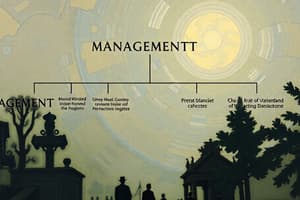Podcast
Questions and Answers
What is the primary goal of the controlling function in management?
What is the primary goal of the controlling function in management?
- Allocating resources and assigning tasks
- Motivating and influencing employees
- Setting goals and objectives
- Monitoring and correcting performance (correct)
What type of organizational structure is characterized by a minimal hierarchy and few levels of management?
What type of organizational structure is characterized by a minimal hierarchy and few levels of management?
- Flat structure (correct)
- Functional structure
- Divisional structure
- Hierarchical structure
What are the unwritten rules and expectations that shape an organization's behavior and identity?
What are the unwritten rules and expectations that shape an organization's behavior and identity?
- Rituals
- Symbols
- Values
- Norms (correct)
What leadership style involves the leader making decisions without input from others?
What leadership style involves the leader making decisions without input from others?
What is the process of exchanging information and ideas between individuals or groups?
What is the process of exchanging information and ideas between individuals or groups?
What is the primary function of planning in management?
What is the primary function of planning in management?
What type of organizational structure combines functional and divisional structures?
What type of organizational structure combines functional and divisional structures?
What are the visible representations of an organization's culture, such as logos and uniforms?
What are the visible representations of an organization's culture, such as logos and uniforms?
Flashcards are hidden until you start studying
Study Notes
Management
- Definition: The process of planning, organizing, leading, and controlling resources to achieve organizational goals.
- Key functions:
- Planning: Setting goals and objectives
- Organizing: Allocating resources and assigning tasks
- Leading: Motivating and influencing employees
- Controlling: Monitoring and correcting performance
Structure
- Definition: The way in which an organization is organized and divided into different components.
- Types:
- Functional structure: Organized by department or function (e.g., marketing, finance)
- Divisional structure: Organized by product or geographic region
- Matrix structure: Combination of functional and divisional structures
- Flat structure: Minimal hierarchy and few levels of management
- Hierarchical structure: Traditional, pyramid-shaped structure with multiple levels of management
Culture
- Definition: The set of values, beliefs, and attitudes that shape an organization's behavior and identity.
- Key components:
- Values: What is important to the organization
- Norms: Unwritten rules and expectations
- Symbols: Logos, uniforms, and other visual representations
- Language: Jargon and communication styles
- Rituals: Ceremonies and traditions
Leadership
- Definition: The process of influencing and guiding others to achieve organizational goals.
- Key styles:
- Autocratic: Leader makes decisions without input from others
- Democratic: Leader involves others in decision-making
- Laissez-faire: Leader gives employees freedom to make decisions
- Transformational: Leader inspires and motivates employees to achieve a shared vision
- Transactional: Leader focuses on achieving specific tasks and goals
Communication
- Definition: The process of exchanging information and ideas between individuals or groups.
- Key elements:
- Verbal communication: Face-to-face, phone, or video conversations
- Nonverbal communication: Body language, tone of voice, and facial expressions
- Written communication: Emails, reports, and other written documents
- Downward communication: From manager to employee
- Upward communication: From employee to manager
- Lateral communication: Between employees at the same level
- Diagonal communication: Between employees from different departments and levels
Management
- The management process involves planning, organizing, leading, and controlling resources to achieve organizational goals.
- Planning involves setting goals and objectives, while organizing allocates resources and assigns tasks.
- Leading motivates and influences employees, and controlling monitors and corrects performance.
Organizational Structure
- Organizational structure is the way an organization is organized and divided into different components.
- Functional structure organizes by department or function, such as marketing or finance.
- Divisional structure organizes by product or geographic region.
- Matrix structure combines functional and divisional structures.
- Flat structure has minimal hierarchy and few levels of management.
- Hierarchical structure is traditional, pyramid-shaped with multiple levels of management.
Organizational Culture
- Organizational culture is the set of values, beliefs, and attitudes that shape an organization's behavior and identity.
- Organization values determine what is important to the organization.
- Norms are unwritten rules and expectations that guide behavior.
- Symbols, such as logos and uniforms, represent the organization visually.
- Language and communication styles, including jargon, are part of the culture.
- Rituals, such as ceremonies and traditions, also shape the culture.
Leadership Styles
- Leadership involves influencing and guiding others to achieve organizational goals.
- Autocratic leaders make decisions without input from others.
- Democratic leaders involve others in decision-making.
- Laissez-faire leaders give employees freedom to make decisions.
- Transformational leaders inspire and motivate employees to achieve a shared vision.
- Transactional leaders focus on achieving specific tasks and goals.
Communication
- Communication is the process of exchanging information and ideas between individuals or groups.
- Verbal communication occurs through face-to-face, phone, or video conversations.
- Nonverbal communication involves body language, tone of voice, and facial expressions.
- Written communication includes emails, reports, and other written documents.
- Downward communication flows from manager to employee.
- Upward communication flows from employee to manager.
- Lateral communication occurs between employees at the same level.
- Diagonal communication occurs between employees from different departments and levels.
Studying That Suits You
Use AI to generate personalized quizzes and flashcards to suit your learning preferences.



